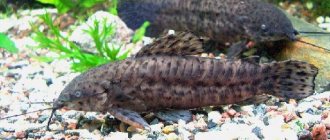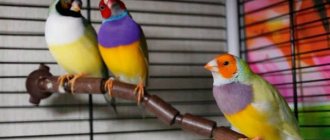Anyone who begins to engage in aquarium keeping, and, probably, already experienced aquarists, never ceases to be amazed at the versatility and unusualness of the existing inhabitants of the depths. Often, having seen one aquarium, many look at it with delight, while forgetting about almost everything in the world. And this is not at all surprising; unusual vegetation, swaying from downward and upward currents, bright fish of all sizes and colors immediately attract the eye of the common man. But among them there are those who, with their unusualness, can attract the attention of any visitor for a long time. Thus, such pets include the incomparable catfish shifters, which will be discussed in today’s article.
Habitat in nature
One of the distinguishing features of these aquarium fish is their unique ability to swim with their belly up. When you see these catfish for the first time, you might think that trouble has happened to them, but you can think so until you get to know them better.
So, first of all, it is worth noting that synodontis catfish are representatives of the family Mochokidae, order Siluriformes. You can meet them by going to the banks of rivers located in Cameroon and Congo. But even here you need to be very careful, since the chance of meeting these fish is significantly higher in places where there is an accumulation of dense vegetation. Some of these places include the Malebo backwater or the tributaries of the Lekini River, known for its transparency and tea-like hue.
Synodontis changeling
A distinctive feature of the species is their ability to swim upside down, collecting food from the surface of the water. This property of fringed moustache gives them the name “changeling”. Insects that have fallen into the water are their main food. And since the fish’s mouth is located at the bottom, in order to eat the prey, they have to turn over with their belly up.
The body of the shifter, colored beige with dark brown or black spots, has the shape of an oblong triangle. Like all types of synodontis, skinwalkers have three pairs of whiskers, but two seem to be fringed and feathery.
These individuals are prone to quickly gaining excess weight, so they must be periodically left without food, while considering the safety of their small neighbors.
Description
First of all, these fish are distinguished by their characteristic tooth structure and the color pigment of the abdomen. And the very name of the genus “Synodontis” and the species “nigriventris” only confirms this. In addition, unlike other fish, whose back color is slightly darker than the belly (this is necessary for protection from aggressive fish or birds), catfish have a darker belly and slightly lighter pigmentation on the back. This distinctive feature of theirs arose due to the fact that they spend almost 90% of their free time swimming in an inverted position. In addition, given the fact that the synodontis changeling picks up food almost on the surface, it is very important for it to observe what is happening in deeper water layers. That is why this body position is the most effective.
In addition, an interesting fact is that when in an artificial reservoir, it is most often located with its belly almost close to the wall.
Changeling catfish have an elongated and laterally flattened body shape, somewhat flattened on the sides. On their head, in turn, there are larger eyes with 3 mustaches that perform a tactile function, which allows these aquarium fish to navigate quite well in space. The mouth of these fish is located slightly lower, which allows them to pick up food both on the water surface and on the bottom.
As for the skin, it completely lacks the skin plates traditional for most fish. In addition, they are completely covered with a special mucous secretion. For protection, representatives of this species have spiny fins located both on the back and on the chest. The caudal fin, in turn, has a clear division into 2 lobes with a rather large adipose fin.
It is interesting that at first this position of the body of this fish caused quite serious discussions among scientists around the world. So most of them were devoted specifically to the issues of controlling one’s body position in space. According to one of them, such an unusual method of movement became available to them due to the unusual structure of the swim bladder. Also, after numerous studies, it was found that this in no way affects either their motor activity or behavioral factor.
Dalmatians and angels
Synodontis Dalmatians is distinguished by its elegant coloring. The body is light with characteristic black spots, like the dog breed of the same name. The white-blue color of the rear fins and the tail with a matching edging are very attractive to aquarists.
The body length of the Dalmatian can reach 20 cm. Like other types of synodontis, this beauty leads a bottom-dwelling nocturnal lifestyle and feeds on any food offered.
The most beautiful of the fringed species is considered to be synodontis angel (stellate). The purple or chocolate-brown body, decorated with yellow or orange spots, really attracts the attention of observers.
The angel grows up to 20-24 cm and with good care will live more than 12-15 years.
Content
First of all, it should be noted that catfish synodontis has a rather peaceful character. Its maximum size is only 90 mm, which allows it to be placed in various multi-species artificial reservoirs, but preferably with neighbors with a similar character.
It is best to keep it in vessels with a minimum volume of at least 80 liters. An exception can be made only if you plan to place only one individual in the aquarium, but this is fraught with quite serious consequences, since these fish prefer to stay in schools.
In addition, the optimal parameters for their content include:
- The water temperature is 24-28 degrees.
- Hardness 5-20 dh.
- Presence of vegetation.
Black catfish and flag synodontis
Sometimes black bagus is classified as synodontis. He's a catfish, but it's "false synodontus." It also turns upside down, but does not belong to the fringed species, does not have pronounced spots on the body, grows up to 35-50 cm and has jumping ability. The catfish bagrus (mystus black) is also called the shapeshifting killer whale. They are predators and eat all fish smaller than themselves.
In flag synodontis, the dorsal fin resembles a flag - its front ray is peculiarly elongated. The color of the fish is silver. Its tail is straight, V-shaped, and black-striped. Moreover, the outfit of males is brighter. Can grow up to 30 cm.
Write in the comments what types of synodontis live in your aquarium.
If the article was useful, please like and share the link to it with your friends on social networks.
Compatibility
Having a peaceful nature, catfish changelings easily get along with almost all types of fish. However, they can be quite aggressive towards some. Thus, it is worth noting that skinwalkers do not touch their neighbors living in the middle and upper water layers. As for fish that feed near the bottom (most often these are corydoras and otocinclus), they can be potential victims of catfish.
The most optimal neighbors of these catfish include:
- dwarf cichlids;
- African tetras;
- small Mormyrid cichlids.
They also get along well with each other. But here you should be careful, since having a rather complex hierarchical ladder, a smaller and weaker relative may be subject to frequent attacks from his brothers. Therefore, at the first such signs, it is recommended to take some measures, including transplantation into another vessel.
In addition, it would not be a bad idea to place several driftwood in the aquarium, which will become a good shelter for the catfish changelings. An interesting fact is that when approaching a tree, they can change their color to a darker one, becoming almost indistinguishable from wood.
Reproduction
Although their maintenance is not associated with serious difficulties, as for their reproduction, there is very little information here. In their natural environment, during the spawning season, they migrate to flooded forests during the rainy season. There is an opinion that it is under the influence of changing climatic conditions that spawning is stimulated. So, as a stimulant, some experienced aquarists recommend using a water change simultaneously with cold water.
Also quite controversial is the statement that spawning occurs on depressions in the substrate or holes that are prepared by the catfish themselves.
The maximum number of eggs that a female can lay rarely exceeds 450. The first fry appear already on the 4th day. Initially, the young swim in the standard way for fish, but after 7-5 weeks they begin to turn over. The best food for young catfish is brine shrimp and microworms.
Also, according to recent studies conducted by American scientists, it is best to use hormonal injections as a simulator of spawning in these fish. After this, the sperm and eggs must be squeezed out and the eggs must be artificially fertilized, followed by incubation.
Characteristics of varieties
Scientists know more than 150 species of these fish. Moreover, not all of them are described. Only a few are the most popular among aquarists.
Catfish cuckoo
Its Latin name is synodontis multipuctatus , which means multi-spotted synodontis. This catfish is very popular among aquarium owners who breed Tanganyika cichlids.
Synodontis like to hide in cover.
This fish is called cuckoo because during the breeding season it quickly swims past spawning cichlids and throws its own eggs into their clutches. The Labidochromis female takes them for her own and hides them in her mouth during the entire incubation period.
The skin of synodontis multipunctatus is light with a yellowish tint. There are dark spots of different configurations and sizes throughout the entire body area. In aquarium breeding conditions, the fish can grow up to 12 cm in length. Males are easy to distinguish from females. They are slimmer and have brighter colors. It is not difficult to keep Synodontis multispotted. You need to give them an aquarium with a volume of at least 80 liters. Inside it there should be various shelters: artificial grottoes, caves and snags.
To prevent catfish from damaging their delicate antennae in the aquarium soil, there should be no sharp elements. Therefore, when creating a substrate, it is better to use coarse river sand, small pebbles and gravel without pronounced corners.
Water parameters:
- it must have a neutral acid-base balance;
- hardness within 15−20 °F;
- temperature ranges from 23 to 28 °C;
- high level of aeration and filtration.
To maintain the health of pets, the aquarist will have to completely change at least one fourth of the total volume of water in the aquarium at least once a week.
Diseases
Although representatives of this species are quite hardy fish, they are still susceptible to various diseases, although not as often as others. Also pleasing is its susceptibility to diseases, to which other tropical fish are very susceptible.
It is especially worth noting that it is necessary to carefully monitor the level of nitrate concentration in an artificial reservoir, an increase in which will not only significantly complicate the spatial orientation of these catfish, but will also negatively affect their nutrition. So, their optimal level should not exceed 20 ppm.
As preventive procedures aimed at reducing even the slightest likelihood of developing possible diseases in these fish, it is recommended to provide them with a comfortable habitat and a balanced diet.
Feeding
The cuckoo catfish is considered not only an omnivorous fish, but also an aquarium cleaner. He happily eats algae from the walls of the aquarium, worms, snails and, in some cases, even carrion.
For the full development of fish and further maintenance of its health, the animal’s diet should consist of 70% protein foods:
- Worms;
- Koretra;
- Insects.
The rest of the menu is occupied by plant and dry food.
Dry food should only be purchased at pet stores. They must be designed specifically for catfish. The serving size and its composition are indicated on the packaging.
Multispotted synodontis are prone to overeating, and, as a result, obesity. You need to feed the fish once a day in the late afternoon (1 - 2 hours before the end of daylight). The serving size is determined by the amount that the flock can eat in 4 - 5 minutes. Next, the remaining food is caught and removed.











